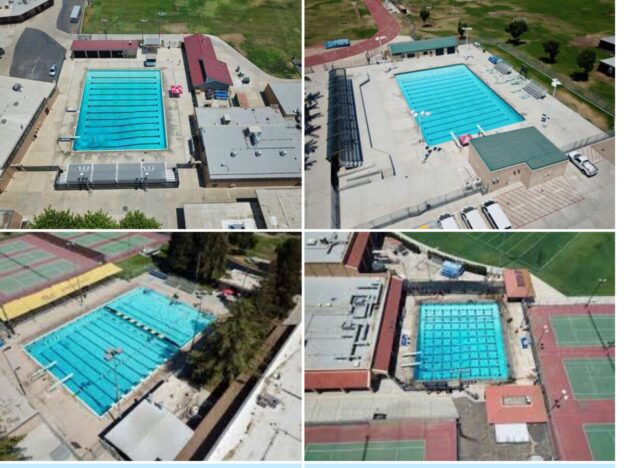In the heart of Visalia, a growing concern has been quietly rippling through the community: our aquatic facilities are falling behind. Visalia’s pools are stuck in the past, but a proposed community pool could change everything.
By: Ariana Lopez Salguero
Building on the insights from my last piece, Why Our High School Pool is Struggling: A Deep Dive into the Issues, I highlighted the need for a better pool for Redwood High School and a community pool to foster both public health and athletes’ development.
Building on that discussion, this article explores the efforts currently underway, started by former Mayor and long-time City Council member Greg Collins, to secure funding for a new aquatic complex and a commitment from the City Council.
Collins, also Redwood’s former water polo coach, ecology instructor, and lifelong advocate for aquatics, has spent the last seven years campaigning for a new, inclusive aquatic complex that would serve the entire community. From serving young children who are learning to swim, to senior citizens who are seeking water aerobics.
His personal experience runs deep. He started coaching water polo in 1977 at the old Recreation Park pool and helped start Visalia’s original swim team, the Vikings, which later grew into three separate teams: the Waves, Seahawks, and Buccaneers. His wife even helped launch one of them.
The problem is that Visalia currently lacks an aquatic complex that can host regional events, serve multiple school teams, and provide year-round access to the public.
Visalia has Riverway Sports Park and its most popular features include the soccer fields, softball complexes, and baseball complexes; meanwhile the aquatics factor is nowhere to be seen. Although there is a splash pad feature mostly for children, Visalia needs a commitment to an aquatic facility where high schoolers and junior high students can compete.
The first public pool constructed in Visalia was the Natatorium, built in 1896, Visalia’s second pool, called the Plunge, was constructed in 1939, Next came Recreation Park, built in the 1950s and demolished in 1986. Mt. Whitney’s pool was built in 1958 and remodeled in 2000, Golden West’s pool in 1985 and remodeled in 1990, and El Diamante’s was built in 2007. The College of the Sequoias pool, built in 1964, is also outdated. In contrast, communities throughout the Central Valley have invested in aquatic centers, leaving Visalia struggling to keep pace.
Collins’ passion for aquatic programs goes beyond sports. He said, “There’s a health aspect, safety for kids, and economic development tied to aquatic complexes.” An aquatic facility promotes longevity and a healthier lifestyle, according to the National Drowning Prevention Alliance.
A community pool isn’t just about teaching children to swim, but also about offering adults a place for fitness and seniors a space for water aerobics. “It’s like a convention center with water. It can be anything, whether it’s a swim lesson for a child, a competition for athletes, or a recreational swim for the elderly,” said Collins.
Collins’ perspective on the project is clear. A new aquatic complex would provide long-term benefits for Visalia. “The long-term health impact is significant. Whether it’s a child learning to swim or an older adult staying fit, this complex would have something for everyone.”
Beyond that, it would attract state competitions, bringing in revenue from out-of-town teams and visitors, and contributing to the local economy.
While Collins had worked tirelessly, including forming committees and presenting his proposal to the city councils and local boards, progress has been slow. “We need the green light from the city council. Without it, we’re at a standstill. But once we get that commitment, the community will rally behind this project,” he said.
Collins said, “I’ve met with every council member. I’ve done the PowerPoint. I’ve exhausted every channel.”
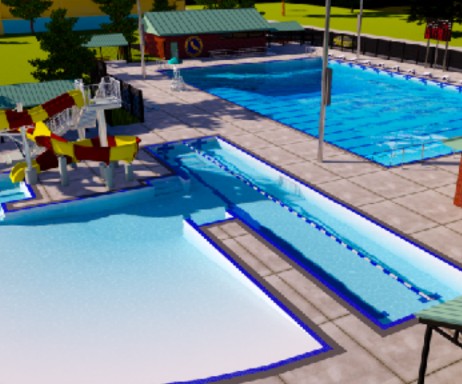
designed to support athletes, families, and the community
Photo courtesy of Collins
For the future, Collins envisions a dual-pool complex. A zero-entry pool with shallow areas that will also include slides, and a full 50-meter pool for competition. “It would be the only facility of its kind in the San Joaquin Valley,” Collins said. “Imagine attracting statewide events, hosting triathlons, and providing swimming opportunities for everyone from toddlers to seniors.”
He has already secured verbal commitments from two donors for a substantial endowment fund to cover ongoing maintenance, potentially offsetting the $300,000 annual cost of operations.
The proposed complex would not only serve as a center for local athletes but would also serve as a backup for high school pools, ensuring that competitions and practices could continue seamlessly if school facilities face issues. Collins sees the broader picture, building a community that elevates Visalia to the level of neighboring cities that have already established aquatic complexes.
“Visalia is falling behind. Places like Clovis, Hanford, and Reedley have modern facilities that allow them to host major events. Why should we be any different?” Collins asks. The message is clear: building a new aquatic complex is not just an investment in recreation—it’s an investment in the future of Visalia’s residents, its economy, and its reputation.
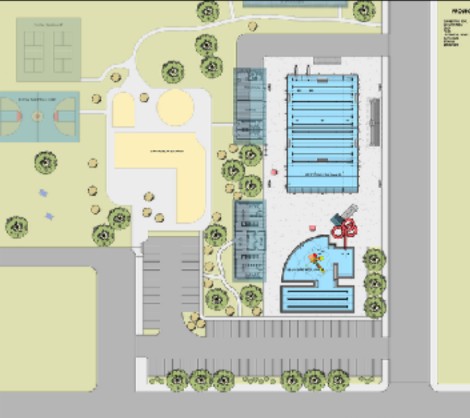
Center, aiming to expand recreational and competitive
opportunities in Visalia
Photo courtesy of Collins
Collins emphasized that the effort is about building something sustainable for future generations. “If you want to grow a sport or a community, you need three things: a good coach, good athletes, and a good facility. We have the first two.”
“This isn’t just about competition,” said Collins. “It’s about health, safety, economic development, and quality of life.”
As temperatures in Visalia soar each summer, residents have increasingly called for a public aquatic facility. With growing momentum from community advocates like former mayor and councilmember Greg Collins, the city council is now seriously considering the proposal, but the path forward is layered with financial planning, design considerations, and competing community interests.
Visalia Mayor Brett Taylor, a Redwood High School graduate and current Associate Executive of the Tulare County Association of Realtors, spoke about the current climate on the city council regarding the aquatic facility.
“I can’t 100% speak for everyone else,” Taylor said, noting that Collins had proposed a pool “two or three times” during his earlier terms on the council. “It had been shot down every time. We obviously have a new council now… they’re probably going to be a little more receptive to the idea,” Taylor said.
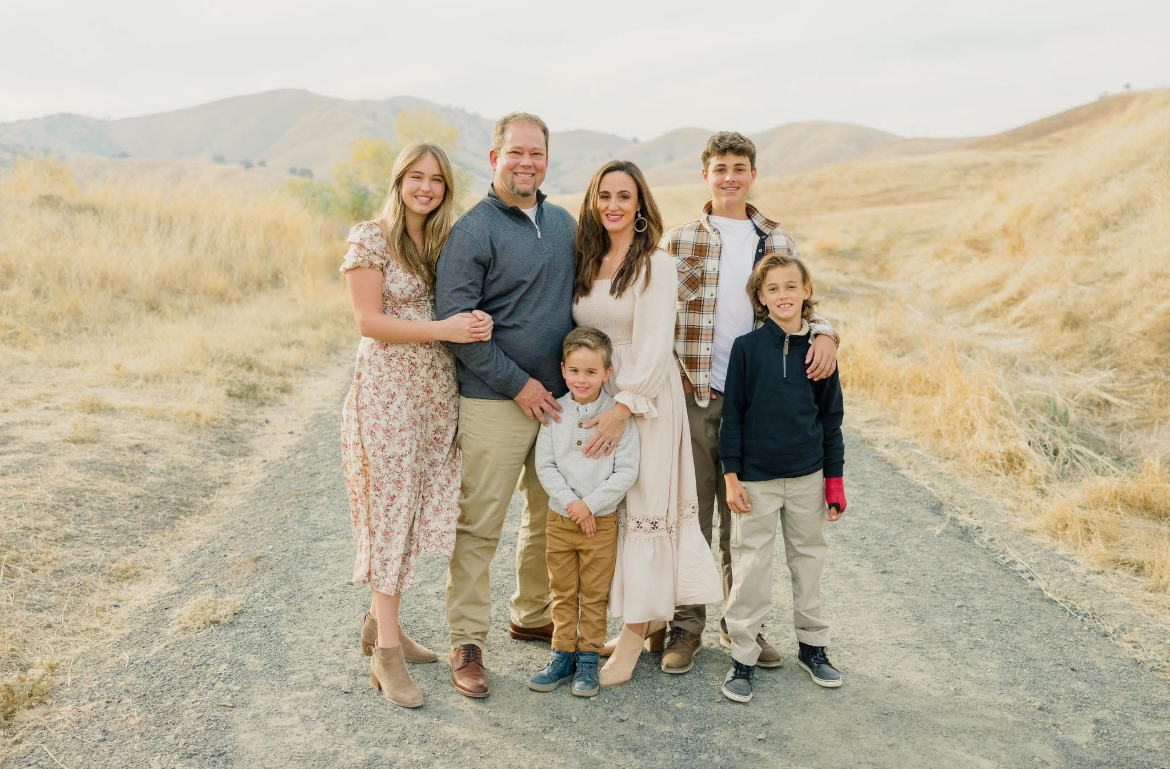
Dolores Taylor, and their four children
Photo @Brett Taylor/Facebook
But enthusiasm alone won’t make the pool a reality. Cost remains one of the largest obstacles. “It’s going to be a huge cost—not only just to purchase a pool, but also maintain it,” Taylor said. “We’ve been told we could possibly get some grants to help build it.”
Taylor emphasized a long-term vision, pointing to the city’s financial discipline over the years. “Visalia has virtually no debt. We’ve been putting aside money to pay off debts and to purchase a new civic center, which we’re doing in cash. Now that we’ve done that, I think we’re finally ready to move on to the next project.”
He’s already brainstorming creative funding strategies. One involves selling city-owned land originally purchased for park use. “When we bought it, it was kind of out in the middle of nowhere, and now it’s worth a decent amount. I was thinking, why don’t we sell this, use some of the funds to buy new parkland, and use the remaining money, potentially a few million dollars, to help fund a pool.”
Visalia’s summer heat and family needs are also part of Taylor’s motivation. “I have four kids. When they were younger, we didn’t have a pool, and it would’ve been nice to have somewhere to go swimming,” he said. “Our playground equipment gets so hot after 10 a.m. in the summer, it’s basically unusable.”
As for what kind of facility the city might build, Taylor said that’s still up in the air. “Do we want Olympic-sized pools for races and water polo, or something more recreational? Some have proposed a smaller kiddie pool with splash features. Realistically, there are a lot of options.”
The process itself, he emphasized, is slow and complex. “If I were optimistic, I’d say maybe this year or next year we could vote on something like this,” Taylor said. “But realistically, if everything went perfectly, construction wouldn’t start for another two to three years. Government timelines just move slower—there’s outreach, planning, cost analysis, RFPs… It’s a big process.”
The council has also heard from groups with competing recreational needs. “There’s definitely support for a pool, but we’ve also had BMX bike groups, baseball supporters, and people wanting indoor basketball arenas show up,” he said. “Everyone has something they’re passionate about. The squeaky wheel gets the grease.”
Still, Taylor appreciates the passionate efforts of community members like Collins and others. “There is a group of individuals who have been very vocal, and that’s great. Greg did a great job reaching out and even secured some potential funding commitments from organizations. That helps a lot.”
As a former student-athlete and long-time Visalia resident, Taylor understands what’s at stake. “I graduated from Redwood in 1999, played football and baseball, and now I’m raising four kids here. I want to see Visalia continue to grow in the right way.”
Whether the city builds an Olympic-style aquatic center or a community splash zone, one thing is clear: the conversation is finally being taken seriously. With persistent advocacy, careful budgeting, and a united vision, Visalia could see a public pool in the next few years.
Tom Felsted, is the head coach for Visalia’s Club Water polo Team, called V’nited. As well as a three-time NCAA water polo champion from UC Berkeley and a recipient of the Ted Newland Coaching Award, he has been coaching water polo at all levels. From youth teams to college programs since 1991.
Many surrounding towns like “Tulare, Hanford, and Porterville each have a 50m pool,” Felsted said. “We have three high school pools that can sustain their respective high schools, but Redwood’s pool is inadequate; woefully so.”
Felsted said that “Many Visalians have little to no access to aquatic facilities. Whether this is cultural or economic, viable access is disrupted because so many are competing for limited space.” Felsted said, “Equally impacted are the truly outstanding athletes.”
“For the first time this century, a USA Water Polo club event was hosted in Visalia by Visalia United Water Polo Club,” Felsted said. “Teams from over 100 miles away came to compete yet we had to use two pools to accommodate just 24 games.”
“Other places can offer that at a single site.” Without a large, dedicated aquatic facility, he explained, Visalia struggles to host major events efficiently, putting the city at a disadvantage.
The benefits of a full-scale aquatic center would extend far beyond sports. Felsted said, “Comprising therapeutic equipment and programs, training pools and dive platforms enhances a community by allowing all ages and experience levels an opportunity to utilize the facility.”
Overall enhancing Visalia’s lifestyle and activities with “Regional and community events [blossoming].” And motivating kids from early ages to engage in aquatic participation, beocming a healthy lifestyle choice.
Felsted pointed Visalias ongoing exclusion from major athletic events, saying the city Is rounintely overlooked for CIF finals and the regional competitions. “Large events pass by Vsialia,” he said. “We are not considered a destination from swim meets or water polo matches.” he stressed that investing ina modern aquatic facility is essential if the city hopes to serve its athletes and attract statewide attention.
For Felsted, the limitations of Visalia’s aquatic facilities represent more than missed meets, they represent missed opportunities for growth, discipline, and achievements. “Water polo, swimming, and diving, like all crafts, require dedicated, diligent hours,” he said. “We are unable to provide that with our current capacity.” Yet he remains hopeful that with community leadership, Visalia can build a facility worthy of its athletes and finally become a destination for excellence, not just ambition.
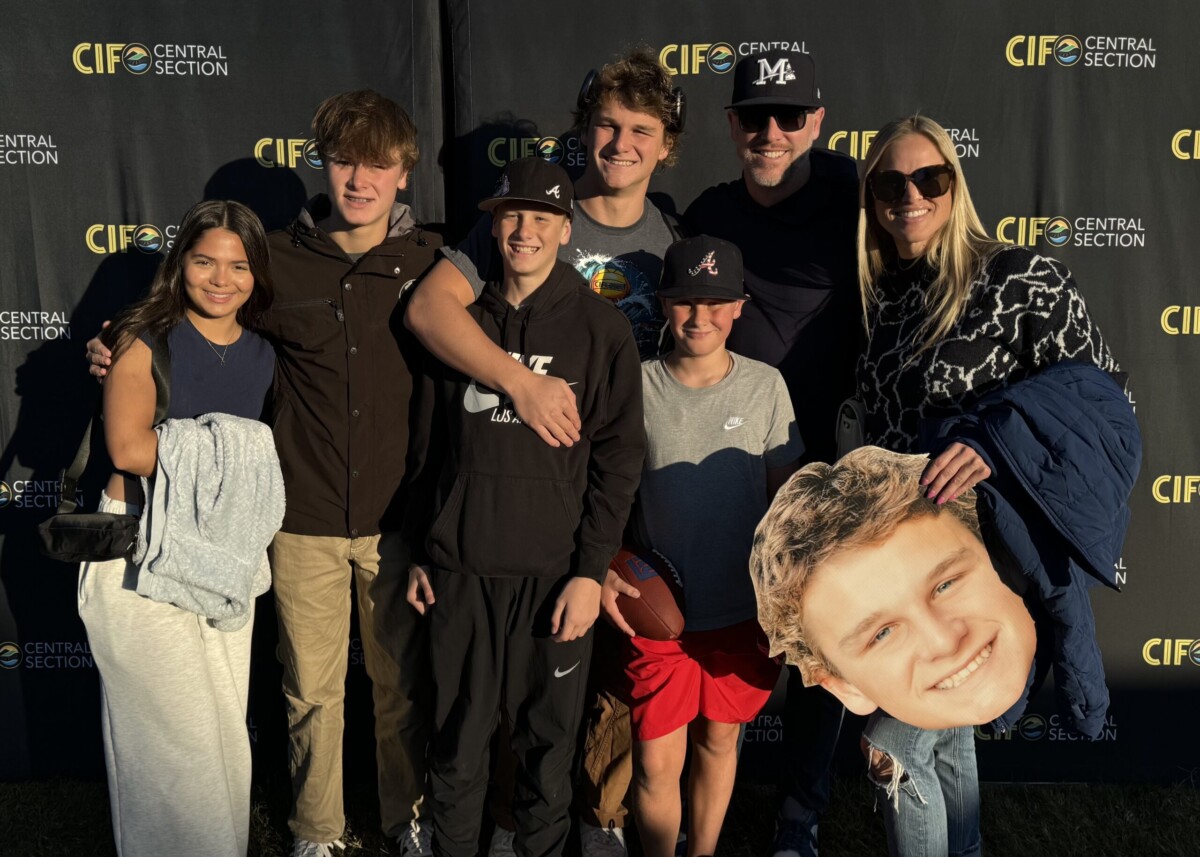
Spencer and their family
Photo courtesy of Anderson
Nicole Anderson is a wife to Spencer Anderson and a mother to four boys. Deeply involved in local aquatic sports, believes an aquatics center would be transformative for the city. Their kids have been avid participants in everything aquatics. Living in Visalia for 8 years, Anderson said, “All 8 years, we have been involved with aquatic sports. We are involved with the Visalia Recreation Buccaneer Swim Team, club water polo with V’nited, Redwood Swim Team, and Redwood Water Polo. As you can see our family spends a lot of time in the water.”
What began as a way to keep her kids active during the hot summer months had grown into a deep love for competitive swimming and water polo. Anderson said, “What started as an outlet to stay active in the summer has turned into a love for the sport of water polo and swimming competitively.”
Navigating the challenges of limited pool access, Anderson said, “we’ve traveled to nearby towns on many occasions to use their pools because we did not have a space in our community to practice or host an event.”
Still, Anderson is optimistic about what an aquatics center could offer, “It would showcase Visalia as a place where we care about a connected community, its growth, health, and continual development.”
Anderson said, “The aquatics community in Visalia is phenomenal, it is a continually growing community, with passionate coaches, athletes and families who want to see their kids succeed. It is a tight knit family that cheers on, supports and encourages each other through thick and the thin.”
For Anderson, it’s about more than just sports, it’s about investing in a culture of teamwork, resilience, and pride in Visalia’s future.
For Anderson, aquatic sports have shaped more than just athleticism in her children, they’ve shaped character. “We see sports as an avenue to teach our kids many valuable life skills such as; how to work hard, win and lose as a team, set and achieve goals but also learn to experience disappointing failures.”
Visalia is just as good, if not better than these many surrounding towns that have aquatics centers. Let’s bring something to our community that can showcase how amazing our town is and that we care about our youth and creating a culture of community. Having a space where we can live, grow and succeed together is a very important piece to a successful community.
Anderson said, “Having an aquatics center would provide a space that promotes taking your sport to the next level. It would be a space that would be able to accommodate tournaments, meets and competitions.”
Anderson highlighted the broader potential of the new aquatics facility, saying, “Visalia being centrally located would be a great place to welcome families from all over California who also share this same passion and love for aquatics sports and community relationships.”
Tags: aquatics, clubs & lifestyles, dive, Frank Bell Community pool, pool, rangers, Redwood, redwood gigantea, redwood high school, redwood journalism, redwood rangers, redwood sports, redwood water polo, rhs, rhs water polo, swim, swimming, visalia ca
